Approaches to curriculum design
The document discusses the key features of curriculum design: 1. It outlines the six main features of any curriculum - the teacher, learners, subject matter, teaching methods, performance assessment, and community partnerships. 2. It then examines the three main approaches to curriculum design - learner-centered, subject-centered, and problem-centered. The learner-centered approach focuses on the needs, interests, and abilities of students. The subject-centered approach emphasizes teaching detached subject matter. And the problem-centered approach views students as problem-solvers through experiential learning. 3. It emphasizes the importance of designing curricula that prepare students for the future by teaching relevant skills and adapting to changes
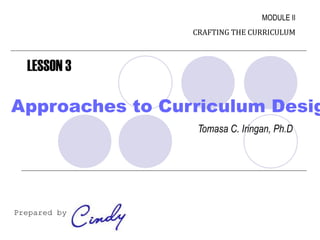
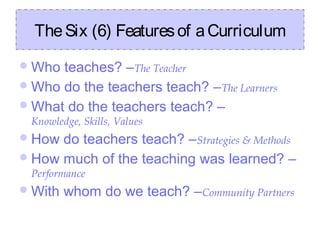

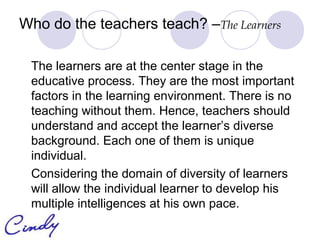
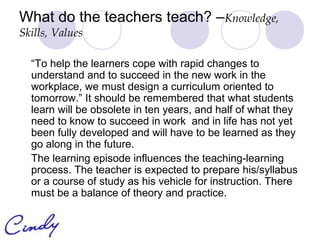
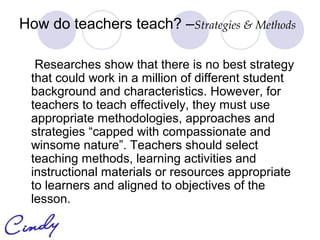
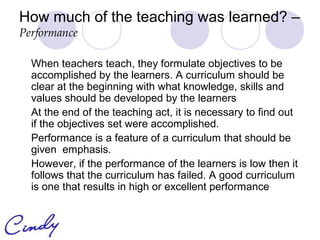
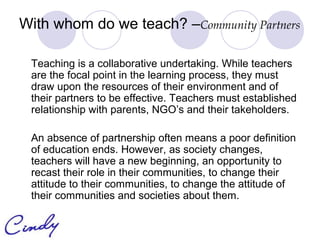


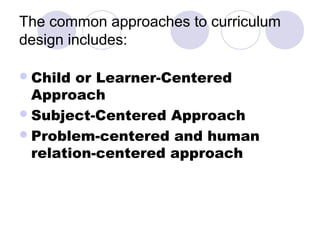
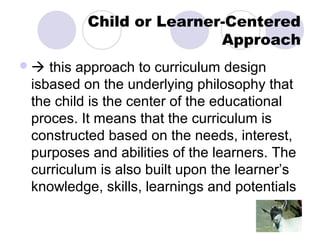
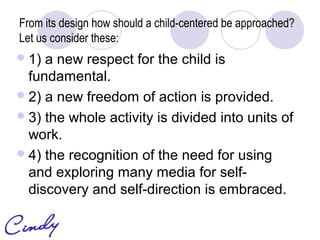
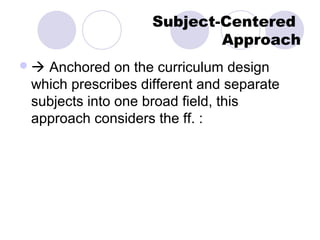
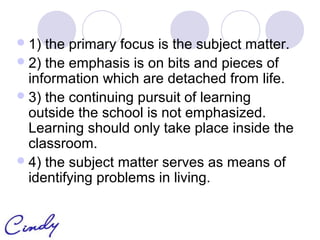

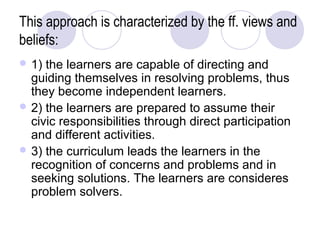
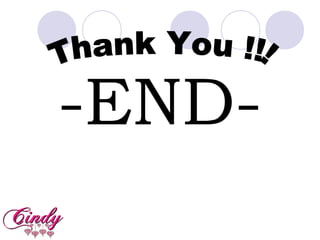
Recommended
More Related Content
What's hot (20)
Similar to Approaches to curriculum design (20)
Approaches to curriculum design
- 1. MODULE II CRAFTING THE CURRICULUM LESSON 3 Approaches to Curriculum Desig Tomasa C. Iringan, Ph.D Prepared by: Cindy Leah A. Sorizo
- 2. The Six (6) Features of a Curriculum ’ü¼ Who teaches? ŌĆōThe Teacher ’ü¼ Who do the teachers teach? ŌĆō The Learners ’ü¼ What do the teachers teach? ŌĆō Knowledge, Skills, Values ’ü¼ How do teachers teach? ŌĆōStrategies & Methods ’ü¼ How much of the teaching was learned? ŌĆō Performance ’ü¼ With whom do we teach? ŌĆōCommunity Partners
- 3. Who teaches? ŌĆōThe Teacher Quality Education requires quality teachers. Good teachers bring a shining light into the learning environment. They are ideal companions of the learners. With the advances in communication technology, good teachers are needed to sort out the information from the data that surround the learners. Good teachers are needed to sort out the knowledge from the info. but even more important, excellent teachers are needed to sort the wisdom from the knowledge. Institutions are as good as its teachers.
- 4. Who do the teachers teach? ŌĆōThe Learners The learners are at the center stage in the educative process. They are the most important factors in the learning environment. There is no teaching without them. Hence, teachers should understand and accept the learnerŌĆÖs diverse background. Each one of them is unique individual. Considering the domain of diversity of learners will allow the individual learner to develop his multiple intelligences at his own pace.
- 5. What do the teachers teach? ŌĆōKnowledge, Skills, Values ŌĆ£To help the learners cope with rapid changes to understand and to succeed in the new work in the workplace, we must design a curriculum oriented to tomorrow.ŌĆØ It should be remembered that what students learn will be obsolete in ten years, and half of what they need to know to succeed in work and in life has not yet been fully developed and will have to be learned as they go along in the future. The learning episode influences the teaching-learning process. The teacher is expected to prepare his/syllabus or a course of study as his vehicle for instruction. There must be a balance of theory and practice.
- 6. How do teachers teach? ŌĆōStrategies & Methods Researches show that there is no best strategy that could work in a million of different student background and characteristics. However, for teachers to teach effectively, they must use appropriate methodologies, approaches and strategies ŌĆ£capped with compassionate and winsome natureŌĆØ. Teachers should select teaching methods, learning activities and instructional materials or resources appropriate to learners and aligned to objectives of the lesson.
- 7. How much of the teaching was learned? ŌĆō Performance When teachers teach, they formulate objectives to be accomplished by the learners. A curriculum should be clear at the beginning with what knowledge, skills and values should be developed by the learners At the end of the teaching act, it is necessary to find out if the objectives set were accomplished. Performance is a feature of a curriculum that should be given emphasis. However, if the performance of the learners is low then it follows that the curriculum has failed. A good curriculum is one that results in high or excellent performance
- 8. With whom do we teach? ŌĆōCommunity Partners Teaching is a collaborative undertaking. While teachers are the focal point in the learning process, they must draw upon the resources of their environment and of their partners to be effective. Teachers must established relationship with parents, NGOŌĆÖs and their takeholders. An absence of partnership often means a poor definition of education ends. However, as society changes, teachers will have a new beginning, an opportunity to recast their role in their communities, to change their attitude to their communities, to change the attitude of their communities and societies about them.
- 9. What do the teachers teach? ŌĆōKnowledge, Skills, Values ŌĆ£To help the learners cope with rapid changes to understand and to succeed in the new work in the workplace, we must design a curriculum oriented to tomorrow.ŌĆØ It should be remembered that what students learn will be obsolete in ten years, and half of what they need to know to succeed in work and in life has not yet been fully developed and will have to be learned as they go along in the future. The learning episode influences the teaching-learning process. The teacher is expected to prepare his/syllabus or a course of study as his vehicle for instruction. There must be a balance of theory and practice.
- 10. Approaches to Curriculum Design
- 11. The common approaches to curriculum design includes: ’ü¼ Child or Learner-Centered Approach ’ü¼ Subject-Centered Approach ’ü¼ Problem-centered and human relation-centered approach
- 12. Child or Learner-Centered Approach ’ü¼’āĀ this approach to curriculum design isbased on the underlying philosophy that the child is the center of the educational proces. It means that the curriculum is constructed based on the needs, interest, purposes and abilities of the learners. The curriculum is also built upon the learnerŌĆÖs knowledge, skills, learnings and potentials
- 13. From its design how should a child-centered be approached? Let us consider these: ’ü¼ 1) a new respect for the child is fundamental. ’ü¼ 2) a new freedom of action is provided. ’ü¼ 3) the whole activity is divided into units of work. ’ü¼ 4) the recognition of the need for using and exploring many media for self- discovery and self-direction is embraced.
- 14. Subject-Centered Approach ’ü¼’āĀAnchored on the curriculum design which prescribes different and separate subjects into one broad field, this approach considers the ff. :
- 15. ’ü¼ 1) the primary focus is the subject matter. ’ü¼ 2) the emphasis is on bits and pieces of information which are detached from life. ’ü¼ 3) the continuing pursuit of learning outside the school is not emphasized. Learning should only take place inside the classroom. ’ü¼ 4) the subject matter serves as means of identifying problems in living.
- 16. Problem-centered and human relation-centered approach ’ü¼’āĀ this approach is based on a curriculum design which assumes that in the process of living, children experience problems. Thus, problem solving enables the learners to become increasingly able to achieve complete or total development as individuals.
- 17. This approach is characterized by the ff. views and beliefs: ’ü¼ 1) the learners are capable of directing and guiding themselves in resolving problems, thus they become independent learners. ’ü¼ 2) the learners are prepared to assume their civic responsibilities through direct participation and different activities. ’ü¼ 3) the curriculum leads the learners in the recognition of concerns and problems and in seeking solutions. The learners are consideres problem solvers.
- 18. -END-
